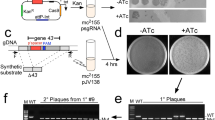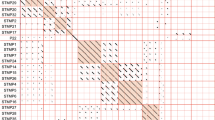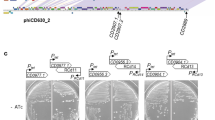Abstract
BACTERIOPHAGE can convert non-toxin producing strains of Corynebacterium diphtheriae to toxinogeny, and the significance of the difference between β-tox+ converting corynebacteriophage isolated by Freeman1 and γ-tox non-converting phage isolated in this laboratory2 has been studied sporadically over the past 20 yr. These two phages are serologically related, but are heteroimmune when tested reciprocally against their lysogenic derivatives3. Both phages exhibit similar one-step growth characteristics and patterns of inducibility by ultraviolet light4 and are morphologically similar though differing slightly in head and tail measurements5. The phages recombine vegetatively, though at a frequency lower than in homoimmune β matings6 and also recombine as prophages in tandem double lysogens7. It has been shown8 that γ non-converting phage probably carries a cryptic tox gene, or part of the gene, as matings between β-tox and γ-tox have yielded tox+ recombinants. These data all suggest that there is a high degree of genetic homology between these two phages. To assess this point more directly we have examined DNA heteroduplexes of the phages and DNA fragments produced by various restriction endonucleases. The data show that the two phages are almost identical.
This is a preview of subscription content, access via your institution
Access options
Subscribe to this journal
Receive 51 print issues and online access
$199.00 per year
only $3.90 per issue
Buy this article
- Purchase on Springer Link
- Instant access to full article PDF
Prices may be subject to local taxes which are calculated during checkout
Similar content being viewed by others
References
Freeman, V. J. J. Bact. 61, 675–688 (1951).
Groman, N. B. J. Bact. 69, 9–15 (1955).
Groman, N. B. & Eaton, M. J. Bact. 70, 637–640 (1955).
Groman, N. B., Eaton, M. & Booher, Z. K. J. Bact. 75, 320–325 (1958).
Holmes, R. K. & Barksdale, L. J. Virol. 5, 783–794 (1970).
Holmes, R. K. & Barksdale, L. J. Virol. 3, 586–598 (1969).
Laird, W. & Groman, N. J. Virol. 19, 208–219 (1976).
Laird, W. & Groman, N. J. Virol. 19, 220–227 (1976).
Groman, N. & Laird, W. J. Virol. 23, 587–591 (1977).
Uchida, T., Pappenheimer, Jr. A. M. J. & Greany, R. J. biol. Chem. 248, 3838–3844 (1973).
Davis, R. W., Simon, M. & Davidson, N. Methods Enzym. 21, 413–427 (1971).
So, M., Gill, R. & Falkow, S. Molec. gen. Genet. 142, 239–249 (1976).
Gill, D. M., Uchida, T. & Singer, R. A. Virology 50, 664–668 (1972).
Lai, C. J. & Northaus, D. J. molec. Biol. 54, 557–565 (1970).
Lang, D. J. molec. Biol. 54, 557–565 (1970).
McDonell, M. W., Simon, M. N. & Studier, F. W. J. molec. Biol. 110, 119–146 (1977).
Author information
Authors and Affiliations
Rights and permissions
About this article
Cite this article
BUCK, G., GROMAN, N. & FALKOW, S. Relationship between β converting and γ non-converting corynebacteriophage DNA. Nature 271, 683–685 (1978). https://doi.org/10.1038/271683a0
Received:
Accepted:
Issue Date:
DOI: https://doi.org/10.1038/271683a0
Comments
By submitting a comment you agree to abide by our Terms and Community Guidelines. If you find something abusive or that does not comply with our terms or guidelines please flag it as inappropriate.



